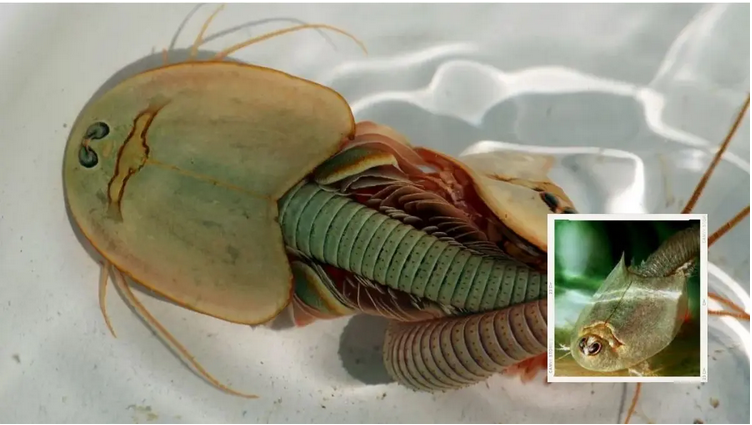Facts about dinosaur shrimp: existed with its three eyes from 419 million years ago and did not become extinct

A freshwater crustacean called tadpole shrimp, or dinosaur shrimp , has a shape resembling ancient armored tadpoles, and it's also called treops, a Greek word meaning three eyes. This type of crustacean has two main eyes, and a third organ called an eye.aIts mission is to discover light.
The name shrimp is usually given to saltwater crustaceans, such as prawns and others, but the Triops, although its name is dinosaur shrimp, is not shrimp, as it has succeeded in adapting to temporary fresh water as well as to saltwater ponds that remain a few weeks before drying out.
Triops has preserved its external appearance since its existence in the Devonian period, 419 million years ago, says Central Michigan University in Mount Pleasant, Michigan, USA, adding that the ancient and morphologically consistent proportions of the Triops prompted some to call it living fossils, the term used to describe fish Usually deep sea.
Triops is one of the survivors of the Triassic period, about 252 million years ago, when dinosaurs first appeared, hence the name dinosaur shrimp. A study came in 2013, saying that Triops had evolved over the past 25 million years.
Evolutionary biologist and lead author of the study, Afrika Gomez of the University of Hull in England, says that living fossils evolve like any other organism, and often have a good body that can survive the test of time, noting that most of the change was internal rather than external in the shape.
Triops are found on all continents, except Antarctica, and include 13 somewhat different genera, and live in Australia, under the name Australian shrimp, and in the United States, except for Alaska, under the name of the summer shrimp tadpole, and it is likely that it reached Japan and the islands Pacific Ocean, as stated by the University of Michigan Books website.
The length of this type of fossil does not exceed 4 cm, but it reaches 9 cm, as in the type of Australian shrimp, which is the largest species.
Triops eggs hatch within two to three weeks, and each of them has both sexual organs, and can reproduce sexually, or produce offspring from unfertilized eggs, which gives it a lot of flexibility to coexist with harsh environments, and perhaps for this reason it still exists to this day .
Triops eggs have the property of dormancy or hibernation during dry periods, meaning that the eggs can stop for up to 27 years, and then return to hatching after the return of the water, according to the study.
This type of fossil is also highly adaptable, and has a varied diet, where they get food through organic matter, hunt zooplankton and insect larvae, and if there is little food, they resort to eating each other.
On the other hand, summer shrimp, a species of thrips, is a pest in rice fields, where it eats small crops and clouds the water, preventing light from reaching plants, according to the University of Michigan.
Although it has survived for millions of years, the troops are facing the threat of extinction today, according to the International Union for Conservation of Environment, and the reason for this is due to human activities, except for the species that lives in the United States, which is classified as safe and does not face the threat of extinction.
https://www.arageek.com/news/triops-dinosaur-shrimp?fbclid=IwAR0XEdjXf2QFU7dpz7G73sGT2OTWt276tFLM8L77VE2dLSG9Ab0daqK1WNw

